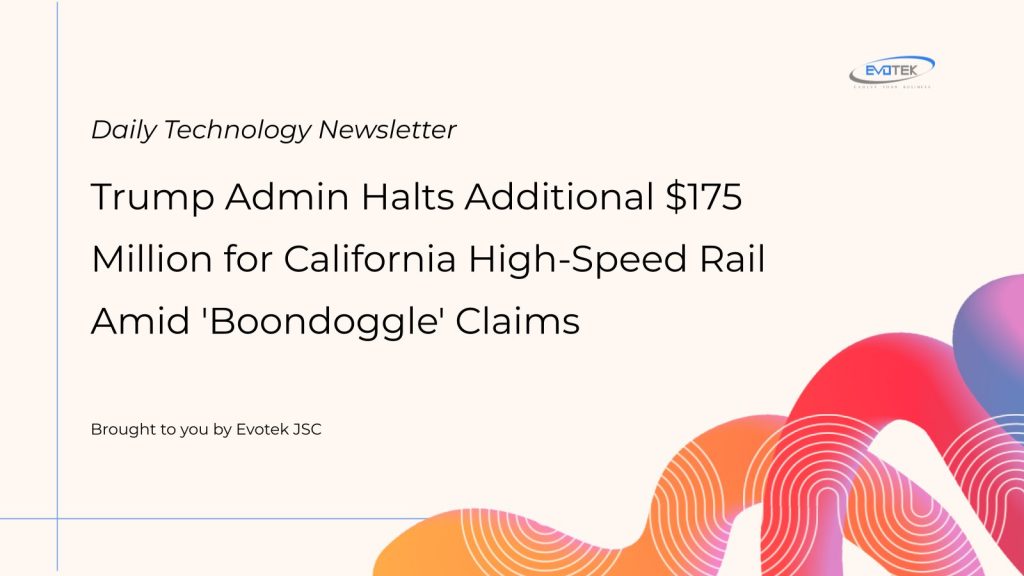The Trump administration has once again targeted California’s ambitious High-Speed Rail project, withdrawing an additional $175 million in federal funding. This latest move escalates an ongoing dispute between the federal government and California’s efforts to build North America’s first true high-speed rail system, already marred by previous funding cancellations and a state lawsuit.
Federal Funding Cut Deepens for California’s Rail Project
On Tuesday, the Department of Transportation (DOT) confirmed the withdrawal of funds that had been previously allocated by President Joe Biden to the California High-Speed Rail Authority (CAHSR). These crucial federal funds were designated for several vital components of the high-speed rail route, including multiple grade separations designed to safely separate vehicle and train traffic, as well as a planned station in Madera, a key point in the Central Valley segment.
A ‘Boondoggle’ Says DOT Secretary Sean Duffy
U.S. Secretary of Transportation Sean Duffy issued a scathing critique of the project, labeling it a “boondoggle” and a significant waste of the nearly $14 billion already invested in its initial design and construction phases. In a sharp rebuke, Duffy stated, “Joe Biden and [former DOT Secretary] Pete Buttigieg didn’t care about these failures and dumped hundreds of millions of dollars into the state’s wish list of related fantasy projects. The waste ends here. As of today, the American people are done investing in California’s failed experiment.”
Secretary Duffy further suggested that the project’s estimated $135 billion price tag could instead fund almost 200 individual roundtrips between San Francisco and Los Angeles for every resident of those cities. CAHSR officials, however, dispute this narrow comparison, noting the system’s broader intended user base and extensive reach beyond just those two major cities.
Administration Shifts Focus to ‘Well-Managed Projects’
Duffy indicated that his department would redirect its focus to “making travel great again by investing in well-managed projects,” though specific alternatives were not detailed. The Trump administration has, however, previously expressed support for Brightline West, a private high-speed rail venture connecting Southern California with Las Vegas, which has itself received substantial federal backing.
California Fights Back Against ‘Political Retribution’
This recent federal funding cut follows closely on the heels of California filing a lawsuit against the Trump administration. The state’s legal action challenges the president’s earlier decision to cancel nearly $4 billion in federal grants for the project. The lawsuit alleges that the termination of federal funding is an act of “petty, political retribution, motivated by President Trump’s personal animus toward California and the high-speed rail project, not by facts on the ground.”
A spokesperson for the California High-Speed Rail Authority echoed these sentiments in a statement to KTLA, condemning the latest withdrawal as “a continuation of the Trump Administration’s illegal, politically motivated, and baseless attack on California High-Speed Rail and Central Valley communities.” The Authority emphasized its commitment, stating, “The facts are clear: California is delivering the only true high-speed system under construction in North America.”
Officials also confirmed that the Authority is close to acquiring the necessary track and system components for installation along the Central Valley corridor within the next year, asserting that “While opponents are recycling tired political attacks, California is building the future of American transportation.”
Charting a New Path Forward: State Funding Initiatives
Amidst the federal pushback, Ian Choudri, CEO of the California High-Speed Rail Authority, is actively championing a strategy for dedicated, consistent state funding. This plan proposes allocating up to $1 billion annually for high-speed rail construction, sourced from the state’s cap-and-trade revenue. This stable funding model is seen as crucial for securing project financing, accelerating construction timelines, and exploring new revenue streams. California Governor Gavin Newsom has voiced his strong support for this proposal, urging the state Legislature to approve it.
Currently, construction work on the California High-Speed Rail is concentrated on a 119-mile segment within the Central Valley. This section forms the majority of the initial operating segment, with completion anticipated in the early 2030s, aiming to connect key regional hubs.

 日本語
日本語 한국어
한국어 Tiếng Việt
Tiếng Việt 简体中文
简体中文